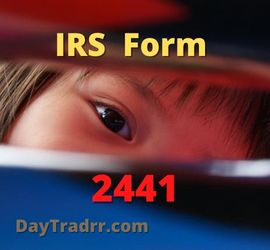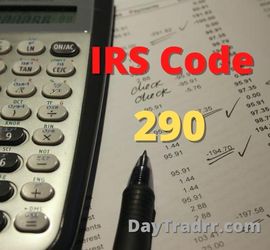IRS Form 2441: Child and Dependent Care Expenses 2022-23
 IRS Tax Form 2441 is a 2-page attachment to your Federal 1040 Tax Return used to claim a tax credit for child and dependent care expenses.
IRS Tax Form 2441 is a 2-page attachment to your Federal 1040 Tax Return used to claim a tax credit for child and dependent care expenses.
Tax Form 2441 is used to report child and dependent care expenses on your tax return. It is an attachment to your 1040 Tax Form to claim a tax credit for those expenses. You may be able to claim a tax credit if you paid someone to look after your child or another qualified dependent so you could work or look for work. Your payments could be to an individual or a care facility. The credit is calculated as a percentage of the amount you spent on a care provider for the care of an eligible individual. Your adjusted gross income determines the percentage. For the first time, the credit is entirely refundable in 2021. This means that a qualifying household can receive the credit even if they owe no federal income tax.
Who Can File Form 2441: Child and Dependent Care Expenses?
The IRS specifies who is entitled to claim the child and dependent care tax credit and how much the benefit is worth. The expenses qualify if you paid someone to care for a dependent in your home including housekeeping services. Care expenses paid to a child or dependent care center are also tax deductible. The following conditions apply:
- Working or looking for work – The care was provided so that you (or your spouse, if you filed jointly) could work or look for a job. However, if you did not find work and had no earned income for the year, you are not eligible for either the credit or the exclusion.
- Qualifying dependent – The care must be for one or more qualifying persons. This includes a qualifying child under the age of 13 or a disabled spouse. Or, another disabled individual you can claim as a dependent and for whom you have paid care expenses.
Tax Credit vs. Tax Deduction
A tax credit equals a dollar-for-dollar reduction in the amount of taxes owed to the IRS. For example, consider a taxpayer who owes $5,000 in taxes and receives a $3,000 tax credit. In that case, the tax burden for that tax year would be $2,000. A tax deduction, on the other hand, simply reduces a person’s income. This results in a reduced amount of taxable income for that year. When the IRS applies the marginal tax rate to the remaining income, a percentage of that income is taxed.
Refundable vs. Non-refundable
If the tax credit is refundable, any credit that exceeds the amount of taxes owed is returned to the taxpayer as a refund. So, if the tax credit was $5,000 and the taxpayer owed $3,000 in taxes, the IRS would issue a $2,000 refund. If a tax credit is non-refundable, the individual will not receive a refund even if the tax credit exceeds the amount of taxes owing for that year. In other words, a non-refundable credit reduces tax liability to zero in the best-case situation.
A tax credit is a dollar-for-dollar decrease in the amount of income tax owed. If you owe $500 in federal taxes but qualify for a $500 tax credit, your net tax burden is zero. Some credits, such as the earned income credit, are refundable. This means you get the whole amount even if the credit exceeds your total tax payment. For example, if your total tax is $500 and you claim a $600 earned income credit, you’ll get a $100 refund. (Source: daytradrr.com)
Child and Dependant Care Tax Credit
President Biden signed the American Rescue Plan on March 11, 2021. This Plan altered the Child and Dependent Credit for 2021. For 2021 only, the Child and Dependent Credit is limited to 50% of eligible expenses up to $4,000 for one qualifying individual and $8,000 for two or more dependents. 5 The IRS computes the tax credit amount based on the total amount of work-related expenses reported to them by the taxpayer. The maximum amount of work-related costs that can be claimed is $8,000 for one qualifying individual and $16,000 for two or more suitable people. 6
Simply put, the $4,000 tax credit cap equals half of the $8,000 maximum in work-related expenses for a single eligible worker. Similarly, the $8,000 tax credit cap represents half of the $16,000 maximum in work-related expenses for two or more qualified individuals. 5 The tax credit is phased out and may be removed based on the amount of income received during the year. For 2021, the 50% tax credit begins to phase out if the taxpayer’s adjusted gross income exceeds $125,000, and it entirely phases out if it exceeds $438,000. In addition, for 2021, the Child and Dependent Credit is refundable. Therefore, even if the credit exceeds the amount of Federal income taxes payable, the individual can claim the entire credit amount. Moreover, the credit amount that exceeds the tax liability is repaid to the taxpayer.
IRS – Form 2441
For 2021, you may claim the credit on qualifying employment-related expenses of up to $8,000 (previously $3,000) if you had one qualifying person, or $16,000 (previously $6,000) if you had two or more qualifying persons. The maximum credit in 2021 increases to 50% of your employment-related expenses, which equals a maximum credit of $4,000 if you had one qualifying person (50% of $8,000), or $8,000 (50% of $16,000) if you had two or more qualifying persons. The more a taxpayer earns, the lower the percentage of employment-related expenses that are considered in determining the credit. Under the ARP, the adjusted gross income level at which the credit percentage starts to phase out is raised to $125,000 for 2021. Above $125,000, the 50% credit percentage goes down as income rises. (Source: irs.gov)
Why Do I Need IRS Form 2441?
Form 2441 is used to calculate the amount of child and dependent care expenses that may be eligible for a tax credit. However, completing this form does not guarantee that you will be qualified for the credit. Instead, it is meant to assist you in calculating how much the credit may be worth to you if you qualify. When submitting your taxes, you must fill out this form and attach it to Form 1040.
You (and your spouse if filing jointly) must have earned income during the year in order to claim the credit. Wages, salaries, tips, and other taxable employee remuneration, are all examples of earned income. Also, net earnings from self-employment. Earned income is reduced when there is a net loss from self-employment. Earned income includes strike benefits as well as any disability pay reported as wages.
Form 2441 – How To Claim Child and Dependent Care Expenses
Form 2441 is a two-page document that asks for particular information about your dependents and child care bills. The following are important boxes to consider:
- Part 1: Care Provider Information – This part contains information about the care provider, such as the provider’s name, address, tax identification number (TIN), and the amount you paid for the service.
- Part 2: Qualifying Dependent – Include the name(s) of any qualified person for whom you paid expenses. Also, list his or her tax ID number, and the total amount spent in this section.
- Part 3: Dependent Care Benefits – If your employer provided you with any dependent care benefits throughout the year, you may be entitled to deduct all or a portion of them from your income. In this section, you provide information about any dependent care benefits you receive. These are benefits for any of the qualifying individuals you specified in Part 2.
All pages of Form 2441 are available on the IRS website. Go to IRS.gov/OrderForms to order current forms, instructions, and publications. Or, call 800-829-3676 to order prior-year forms and instructions. The IRS will process your order for forms and publications as soon as possible. However, you can get forms and publications faster online.
IRS Tax Form 2441 FAQs
What Is IRS Form 2441?
IRS Form 2441: Child and Dependent Care Expenses is used to report child and dependent care expenses. It is a 2-page attachment to your Federal 1040 Tax Return used to claim the tax credit. The cost of paying a care facility to watch for a child or qualifying dependent may be eligible for a tax credit.
What Are Qualified Expenses for IRS Form 2441?
Qualified expenses include amounts paid for domestic services and care of the qualifying individual. This care must be provided while you are working or looking for work. Household services include a babysitter, housekeeping, or cleaning service if it is used to care for the qualified individual. Care expenses do not include expenditures paid for food, accommodation, clothes, education, or amusement. Small sums spent on these things can be included. Provided, they are incidental to and cannot be separated from the expense of caring for the eligible person.
Can Form 2441 Be E-Filed?
Form 2441 can be filed alongside Form 1040 if you file your tax return electronically. When choosing an e-filing tax package, be sure it includes inquiries about child and dependent care expenses. If you plan to file a paper return, you can hand-fill Form 2441 and mail it with your return. The mailing address will be determined by your location. The IRS website has a comprehensive list of mailing addresses for tax returns.
Up Next: IRS Code 290 on IRS Transcript 2022-23
 IRS Code 290 indicates additional taxes were assessed for various reasons ranging from an audit’s results to a simple math error. When reviewing your tax transcript IRS Code 290 means an Additional Tax Assessed. However, you may not always owe additional taxes. The code may show up even if no taxes are owed. If the amount is larger than $0, you should contact the IRS. Or, you can wait for a letter to arrive detailing the adjustment to your return. To avoid interest and penalties, you should make a payment if you agree with the amount owed.
IRS Code 290 indicates additional taxes were assessed for various reasons ranging from an audit’s results to a simple math error. When reviewing your tax transcript IRS Code 290 means an Additional Tax Assessed. However, you may not always owe additional taxes. The code may show up even if no taxes are owed. If the amount is larger than $0, you should contact the IRS. Or, you can wait for a letter to arrive detailing the adjustment to your return. To avoid interest and penalties, you should make a payment if you agree with the amount owed.
Additional taxes may be payable for a variety of reasons. For example, the results of an audit or inaccurate calculations on your return. Occasionally, the IRS will hold an account for review and then remove the hold with no further tax charged. Nevertheless, you will still see IRS Code 290 on your transcript, but it will reflect a $0 assessment. In other words, a Code 290 with a $0 means that the IRS reviewed your return but assessed no additional tax. Unless you check the status of your return using the Where’s My Refund portal, you may not even be aware there was a review.




